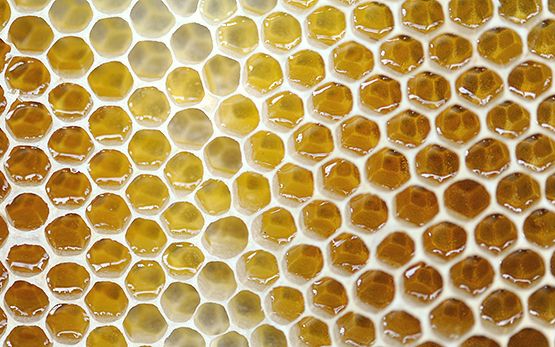Der Wassergehalt des von den Pflanzen produzierten Nektars kann variieren. Um seine Konservierung in den Waben zu gewährleisten, darf er nicht gären. Deshalb wird er von den Bienen in Honig umgewandelt, indem sie seinen Wassergehalt senken und folglich den Zuckergehalt erhöhen. Dies verhindert die Entwicklung der Mikroorganismen. In der Dunkelheit des Bienenstocks ist es schwierig, den Herstellungsprozess des Honigs zu beobachten. Aus diesem Grund ist er auch nur wenig erforscht. Um die Umwandlung von Nektar in Honig zu untersuchen, haben wir die Technik der Tomographie eingesetzt. Sie ermöglicht es, den Zuckergehalt des eingelagerten Nektars sehr präzise zu messen, ohne den Bienenstock öffnen zu müssen und das Bienenvolk zu stören.

Publications Thomas Keller
Mossadeghi-Björklund M., Jarvis N., Larsbo M., Forkman J., Keller T.
Effects of compaction on soil hydraulic properties, penetration resistance and water flow patterns at the soil profile scale.
Soil Use and Management, 35, 2019, 367-377.
Prasuhn V., Weisskopf P., Bucheli T., Keller T., Spiess E., van der Heijden M., Mangold S., Mayer J., Schwab P., Wettstein F., Widmer F., Wittwer R.
Bodenforschung an der landwirtschaftlichen Forschungsanstalt Agroscope.
Dans: Exkursionsführer Bern 2019. Ed. DBG Mitteilungen Band 119. 2019, 84-99.
Vennik K., Kukk P., Krebstein K., Reintam E., Keller T.
Measurements and simulations of rut depth due to single and multiple passes of a military vehicle on different soil types.
Soil and Tillage Research, 186, 2019, 120-127.
Bennett J. McL., Roberton S.D., Marchuk S., Woodhouse N.P., Antille D.L., Jensen T.A., Keller T.
The soil structural cost of traffic from heavy machinery in Vertisols.
Soil and Tillage Research, 185, 2019, 85-93.
Romero-Ruiz A., Linde N., Keller T., Or D.
A review of geophysical methods for soil structure characterization.
Reviews of Geophysics, 56, (4), 2018, 672-697.
Müller L., Sychev V.G., Romanenkov V., Sheudzen A.K., Lukin S., Saparov A., Lück E., Pütz T., Griffiths B., Zhang J., Keller T., Tóth T., Kulikov I.M., Sorokopudov V., Trofimov I.A. et autres
Innovations and knowledge transfer for achieving landscape sustainability.
Dans: Novel Methods and Results of Landscape Research in Europe, Central Asia and Siberia. 2018, Ed. Mueller L. & Sychev V. (eds.), Russian Academy of Sciences / Moscow. 2018, 25-41.
Getahun G.T., Kätterer T., Munkholm L.J., Parvage M.M., Keller T., Rychel K., Kirchmann H.
Short-term effects of loosening and incorporation of straw slurry into the upper subsoil on soil physical properties and crop yield.
Soil & Tillage Research, 184, 2018, 62-67.
Bölenius E., Wetterlind J., Keller T.
Can within-in field yield variation be explained using horizontal penetrometer resistance and electrical conductivity measurements?: Results from three Swedish fields.
Acta Agriculturae Scandinavica, Section B - Soil & Plant Science, 68, (8), 2018, 690-700.
Colombi T., Chargas Torres L., Walter A., Keller T.
Feedbacks between soil penetration resistance, root architecture and water uptake limit water accessibility and crop growth: A vicious circle.
Science of the Total Environment, 626, 2018, 1026-1035.
Keller T., Berger-Landolt U.
Mutter Erde vergisst nur langsam.
BauernZeitung, Online, (2. April), 2018.
Fell V., Matter A., Keller T., Boivin P.
Patterns and factors of soil structure recovery as revealed from a tillage and cover-crop experiment in a compacted orchard.
Frontiers in Environmental Science, 6, 2018, 1-10.
Keller T., Lamandé M., Naderi-Boldaji M., Paiva de Lima R.
Approaches towards understanding soil compaction processes.
Dans: Novel Methods and Results of Landscape Research in Europe, Central Asia and Siberia. Ed. Mueller L. & Sychev V. (eds.), Russian Academy of Sciences FSBSI / Moscow. 2018, 274-279.
Farahani E., Emami H., Keller T.
Impact of monovalent cations on soil structure. Part II. Results of two Swiss soils.
International Agrophysics, 32, 2018, 69-80.
Farahani E., Emami H., Keller T., Fotovat A., Khorassani R.
Impact of monovalent cations on soil structure. Part I. Results of an Iranian soil.
International Agrophysics, 32, 2018, 57-67.
Naderi-Boldaji M., Kazemzadeh A., Hemmat A., Rostami S., Keller T.
Evolution of soil stress during repeated wheeling as affected by soil water content, wheel load and travel speed.
Soil Research, 56, (2), 2018, 204-214.
Farahani E., Emami H., Keller T., Fotovat A., Khorassani R.
Impact of monovalent cations on soil structure. Part I. Results of an Iranian soil.
International Agrophysics, 32, 2018, 57-67.
Wittwer R., Walder F., Büchi L., Schläppi K., Banerjee S., Hirte J., Mayer J., Colombi T., Keller T., Preschl U., Nemecek T., Seitz S., Schloten T., Loaiza Puerta V., Six J. et autres
Bodenfunktionen und Multifunktionalität unter ÖLN-, biologischer und bodenkonservierender Bewirtschaftung.
Dans: 5. Agroscope-Nachhaltigkeitstagung: Multifunktionelle Böden für Landwirtschaft und Umwelt. 18.01.2018, Reckenholz - Agroscope. 2018, 1-14.
Shi P., Thorlacius S., Keller T., Keller M., Schulin R.
Soil aggregate breakdown in a field experiment with different rainfall intensities and initial soil water contents.
European Journal of Soil Science, 68, (6), 2017, 853-863.
Vennik K., Keller T., Kukk P., Krebstein K., Reintam E.
Soil rut depth prediction based on soil strength measurements on typical Estonian soils.
Biosystems Engineering, 163, 2017, 78-86.
Colombi T., Kirchgessner N., Walter A., Keller T.
Root tip shape governs root elongation rate under increased soil strength.
Plant Physiology, 174, 2017, 2289-2301.





